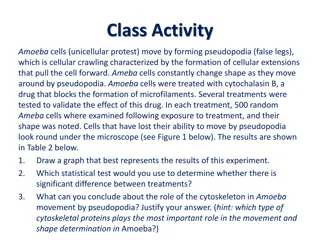Exploring Unicellular Organisms: Amoeba and Euglena Structures and Characteristics
Journey into the microscopic world of unicellular organisms with a focus on Amoeba and Euglena. Discover the unique structures and behaviors of these tiny creatures, from Amoeba's adaptable pseudopod movements to Euglena's photosynthesis capabilities. Uncover how these organisms survive, feed, and r
0 views • 15 slides
Investigation into the Role of Cytoskeletal Proteins in Amoeba Movement
Amoeba cells move by forming pseudopodia, which are cellular extensions due to the cytoskeleton. A study exposed Amoeba cells to drugs disrupting cytoskeletal proteins, showing a significant effect on cell shape. Statistical analysis using Chi-Square test indicated a strong correlation between drug
0 views • 6 slides
Unveiling the World of Unicellular Organisms
Discover the fascinating world of unicellular organisms through examples like Amoeba and Paramecium. Compare the characteristics and functions of unicellular and multicellular organisms, explore their feeding, movement, waste removal, and reproduction processes, and delve into the diversity of cell
0 views • 14 slides
Exploring the Diverse World of Protists Through Microscopic Observations
During this lab exercise, a wide variety of protists were observed, showcasing the diverse characteristics and behaviors within this group. The classification of protists is continuously evolving, focusing on convenience rather than evolutionary relationships. From autotrophs to heterotrophs with an
0 views • 20 slides
Exploring Microorganisms: Amoeba, Radiolaria, and Sporozoa
Discover the fascinating world of microorganisms including Amoeba Proteus, Acanthometron Pellucidum, Heliosphaera Echinoides, and Plasmodium Vivax. Explore the unique characteristics and classifications of Rhizopoda, Radiolaria, and Sporozoa through detailed images and descriptions.
0 views • 24 slides
Exploring the Fascinating Kingdom Protista: Classification and Characteristics
Dive into the diverse world of Kingdom Protista, encompassing a wide range of eukaryotic organisms not classified under animals, plants, or fungi. Discover their classification based on nutrition acquisition and explore animal-like protists, such as zooflagellates, sarcodines, ciliates, and sporozoa
0 views • 21 slides
Understanding Unicellular and Multicellular Organisms in Biology
Explore the basic differences between unicellular and multicellular organisms, including the distinctions between prokaryotes and eukaryotes. Unicellular organisms, such as bacteria and amoeba, consist of a single cell and are often microscopic. Examples of both prokaryotic and eukaryotic unicellula
0 views • 10 slides
Amoeba Cache: Adaptive Blocks for Memory Hierarchy Optimization
The Amoeba Cache introduces adaptive blocks to optimize memory hierarchy utilization, eliminating waste by dynamically adjusting storage allocations. Factors influencing cache efficiency and application-specific behaviors are explored. Images and data distributions illustrate the effectiveness of th
0 views • 57 slides







